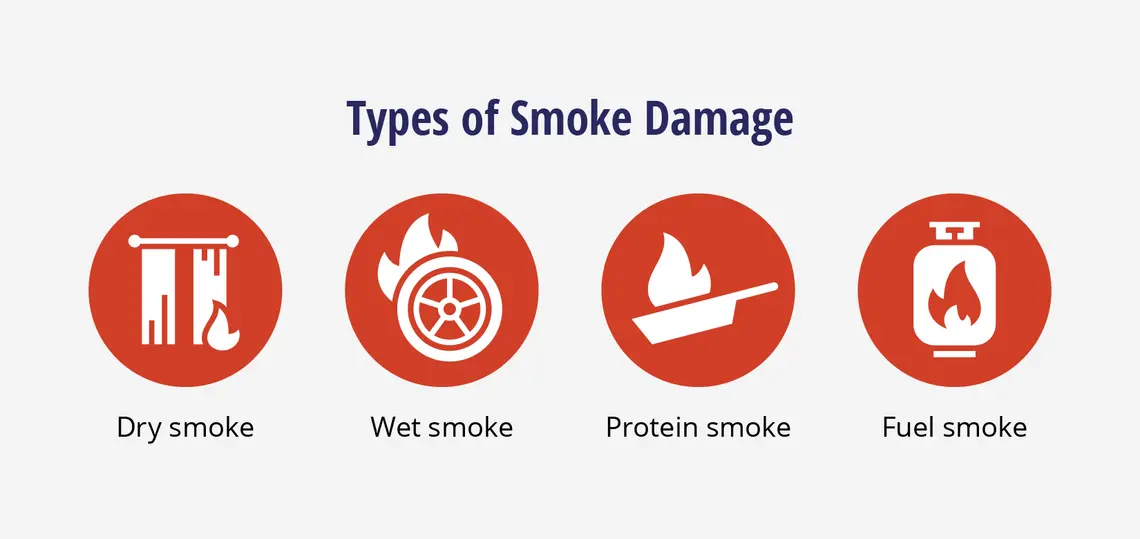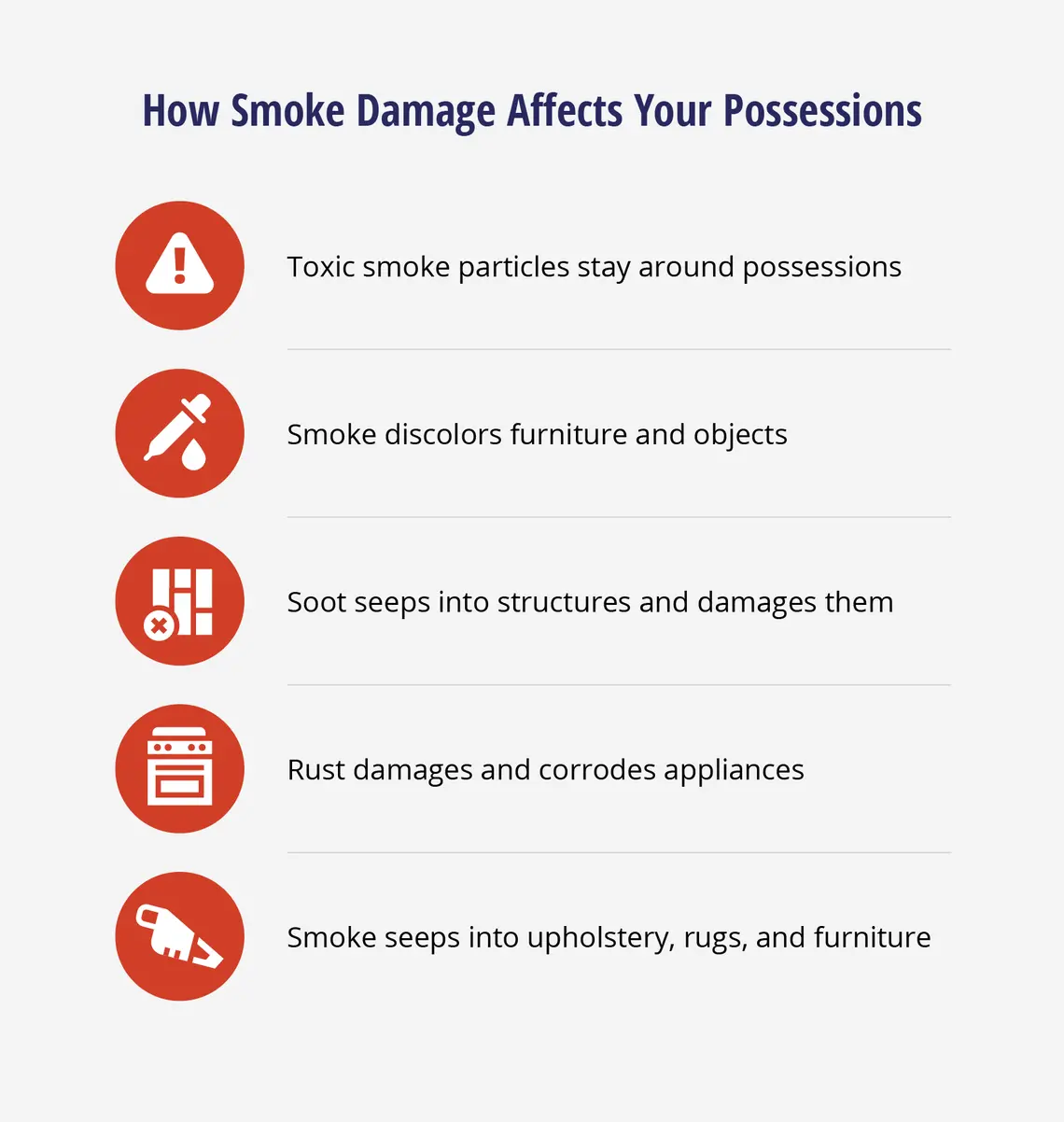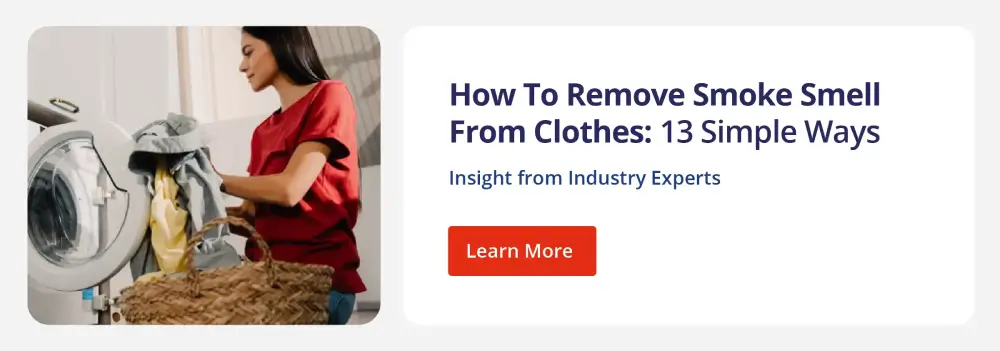-(1).webp)
Smoke damage can have lasting effects on property and health. Rainbow Restoration outlines some key steps for addressing smoke damage.
|
Quick Answer: Smoke damage is the physical damage to a building or object caused by smoke, not a fire itself. If left untreated, smoke damage can destroy a building's structure as well as the items within it.
If a fire breaks out at your home or business, what’s the biggest risk you should look out for? And how can you prepare for it? While a fire poses an immediate threat, that’s not your only concern. Smoke from the fire can cause significant damage, hurting your building’s structure, electrical systems, and any possessions that were exposed to the smoke.
Smoke damage can happen even in small fires that are put out immediately. The cleanup of smoke and soot is time-sensitive. Because smoke is acidic in nature, it affects each surface of a property differently, rapidly taking its toll unless it is quickly and carefully addressed.
To help you prepare for smoke damage, we’ll explain the different types of smoke damage and how it affects your property and share tips for restoring smoke damage.
If you have smoke damage to address, find your local Rainbow Restoration or call 855-724-6269 to request an appointment.
Table of contents:
What Is Smoke Damage?
Smoke damage refers to physical damage caused by smoke and not a fire itself. While smoke doesn’t immediately destroy buildings or objects, it can cause long-term damage. If left untreated, smoke damage leads to corrosion, discoloration, odors, structural weaknesses, and health problems, so being prepared for smoke damage is the key to fixing it quickly.
Temperature, the type of fire (smoldering or blazing), and the materials burned influence necessary cleanup measures. Further complicating matters, smoke particles can easily penetrate any crack and crevice. Proper ventilation, debris removal, cleaning, and odor-neutralizing efforts are critical to saving as many of your belongings as possible. However, timing is the most crucial component of smoke damage restoration.
In addition to smoke damage, fires can coat your property in soot. While soot leads to discoloration and prolongs the cleaning process, it can cause damage, too. Soot burrows into fabric, upholstery, and appliances. It can also corrode hard surfaces, destroy flooring, and damage walls beyond repair.
Types of Smoke Damage
Depending on the type of fire and objects burned, you may come across different kinds of smoke damage. The most common types include the following.

1. Dry Smoke
High-temperature fires that quickly spread cause dry smoke. These fumes often come from paper, wood, and building structures. While residue from dry smoke damage is powdery and easy to clean up, it fits into more spaces. As a result, it can cause structural and internal damage to wiring, HVAC systems, and foundation.
2. Wet Smoke
Wet smoke fumes come from low-heat fires, often involving burnt plastic and rubber goods. Because of its source, wet smoke smells like burnt plastic and leaves a black residue that rusts and corrodes metal products. Because wet smoke leaves grease, it’s more difficult to clean as well.
3. Protein Smoke
Protein smoke comes from burnt organic matter commonly found in kitchens. Unlike other kinds of smoke, protein fumes don’t leave stains or smears on hard surfaces. However, it can discolor paint and has a strong odor.
4. Fuel Smoke
Burning oil, petroleum, and other fuels creates fuel smoke. While it usually doesn’t appear inside homes, it can be found in garages, sheds, and commercial spaces such as warehouses. After settling, fuel smoke thickens and becomes extremely difficult to remove. Once fabric comes into contact with fuel smoke, the damage is irreparable.
How Smoke Damage Affects Home and Business Contents
While smoke damage doesn’t always affect a building’s structure, its contents almost always face damage. Here’s how different types of smoke damage impact your possessions:

Curtains, Carpet, and Upholstery
Smoke and soot particles permeate curtains, carpets, and upholstery. Discoloration sets in quickly for smoke-damaged fabric.
Clothes and Bedding
Clothes and bedding also absorb smoke and soot after a fire. Wearing smoke-damaged clothes or sleeping in smoke-damaged bedding increases the chance of breathing toxic particles.
Furniture
Smoke damages wood and metal furniture. Soot particles can rust and corrode metal while weakening wood. The smoke also causes surfaces to change color.
Hard Flooring
Smoke can seep into hardwood flooring and walls. These soot particles weaken the structural integrity of your home, office, or storefront. It can also corrode pain on these surfaces.
Porous Hard Surfaces
Porous materials such as drywall, plaster, wallpaper, and paint can get discolored due to smoke. If left for too long, the stains become permanent.
Fiberglass and Porcelain
Appliances surfaces, porcelain, and fiberglass yellow within hours if left unaddressed. Because of their light color, once smoke damage discolors these surfaces, you’ve lost your chance to salvage it.
Metallic appliances
Acidic soot can cause metal surfaces, such as large appliances, to pit and corrode over time. Soot that enters their interior can also lead to internal damage and electrical failures.
Plastic and PVC
Plastic surfaces and synthetics collect more smoke than other materials and can discolor within minutes. These services are also more difficult to clean without alkaline cleaning solutions.
What Can Be Salvaged From Smoke Damage?
The more intense the fire, the greater the smoke damage. As a result, you may not get the chance to salvage your property after a blaze. Fabrics and soft surfaces tend to suffer the most damage, next to porous materials and upholstery. That said, harder objects and materials withstand smoke damage much better but are still susceptible to initial and long-term damage.
With professional cleaning services, you can usually salvage structural elements like hardwood floors, countertops, and tile surfaces. In many cases, appliances and equipment like dishwashers and ovens also avoid the worst damage. You may need a content cleaning service for personal belongings including:
- Photographs and artwork
- Furniture
- Clothing
- Documents, books, and other paper materials
- Electronics (televisions, computers, stereos, etc)
- Ceramic and porcelain dishes and decorations
- Jewelry, glassware, and gems
Smoke Damage Cleanup Tips
Even cleaning small amounts of smoke damage can pose a health risk. Thankfully, you can clean a smoke-damaged property by taking the right precautions. Before taking on smoke damage remediation, consider these tips for smoke damage cleaning.
Don’t Jump Into DIY Restoration
While cleaning smoke damage yourself sounds like a good way to cut costs, the risk outweighs the reward. In cases of mild damage, you can save some possessions and clean soot. However, moderate to extreme smoke damage poses greater health and safety risks. Even if you manage to clean the damage safely, you may miss hidden residue and soot buildup.
Prioritize Your Safety
- Make sure the area is safe: Before cleaning any rooms, check for structural damage and potential fire hazards. A smoke-damaged area increases the risk of injury.
- Wear personal protective equipment (PPE): Gloves, masks, and eye protection will keep soot and other contaminants away from your skin, eyes, and lungs.
- Ventilate the smoke: Open all doors and windows before you begin any type of cleanup work. If you have an HVAC system, turn it off durning the cleaning process to avoid spreading contaminants throughout the structure. Also, don’t forget to replace the filters before starting up the system again.
Keep the Timeframe in Mind
The Institute of Inspection Cleaning and Restoration Certification(IICRC), a globally recognized leader in credentials and certifications for the inspection, cleaning, and restoration industries, identifies these time windows:
- Address porous materials and synthetics immediately to prevent permanent discoloration.
- Wooden furniture, flooring, painted walls, and clothing can become permanently stained if not addressed within hours to days of damage, and metal surfaces will, at this point, begin to rust, pit, and corrode, requiring refinishing or replacement.
- Clean fiber materials within weeks. Soot will embed itself into the fibers and surfaces after prolonged exposure, resulting in a longer, more costly restoration with a higher likelihood of replacement.
Check Appliances and HVAC Systems
Smoke damages HVAC systems and electrical appliances. Soot residue inside these appliances can also turn them into a fire hazard. So, always remember to:
- Clean HVAC systems: Smoke particles can get into your heating, ventilation, and air conditioning systems. Have your HVAC system professionally cleaned to prevent recirculating smoke odors.
- Replace filters: Change air filters in your HVAC system, and consider using HEPA filters to capture small smoke particles.
- Inspect appliances and lighting: Make sure your electrical tools and appliances don’t have smoke damage or residue within them. You can take them to a professional cleaner for help. The same goes for your lighting fixtures.
- Check electrical systems: Have an electrician check your wiring and electrical components for any damage caused by the smoke.
Document Damage and Cleanup
As you clean a smoke-damaged area, take pictures before, during, and after the cleanup process is complete. It’s also a good idea to keep an inventory of destroyed or damaged items.
FAQ About Smoke Damage
If you still have questions about the details related to smoke damage cleanup, we have answers. Here are a few frequently asked questions about smoke damage cleanup and restoration.
What Are the Effects of Smoke Damage?
Smoke damage can lead to health risks and structural damage to your property and belongings. The main effects include:
- Discolored and damaged surfaces
- A lingering odor you can’t ventilate
- Harmful chemicals and irritants spread throughout the space
- Weakened wood, drywall, and insulation
- Decreased property value
Does Smoke Damage Ever Go Away?
You can usually restore smoke damage, but it rarely goes away on its own. Depending on the severity of the damage, cleaning it can take a few days to several months. The longer you ignore smoke damage, the more damage it does to your property and health.
How Do You Treat Smoke Damage?
You can treat smoke damage by removing soot and ash from each surface. The American Red Cross recommends using a mild soap or detergent. You can also try 4-6 tablespoons of trisodium phosphate mixed with 1 cup of household cleaner or chlorine bleach. Remember to wear a face mask and gloves as you clean affected areas.
Can You Clean Smoke Damage Yourself?
Whether you opt for professional fire damage cleanup or a DIY approach to smoke damage cleanup, preparation, and care are required to ensure safe and effective results. For the inexperienced, smoke damage cleanup is a difficult, risky, and time-consuming process. Luckily, the experts at Rainbow Restoration® are here to help you determine what can and cannot be salvaged in a safe and timely manner. The experienced team at Rainbow Restoration uses the most effective tools and cleaning methods to ensure the best possible results.
Acting fast to prevent the disastrous effects of smoke damage is essential to a safe and effective recovery. Don’t wait, contact the IIRC-certified restoration experts at Rainbow Restoration today!
This article is intended for general informational purposes only and may not be applicable to every situation. You are responsible for determining the proper course of action for your property. Services should be performed by licensed and experienced professionals. Rainbow Restoration is not responsible for any damages that occur as a result of this blog content or your actions. For the most accurate guidance, contact a Rainbow Restoration professional for a custom, on-site assessment.

